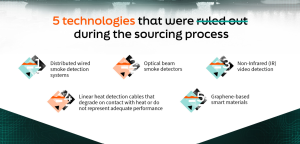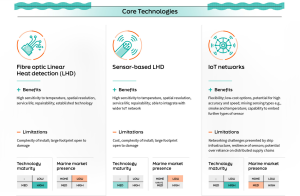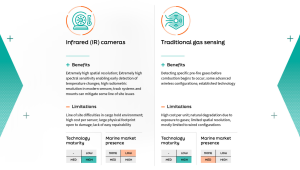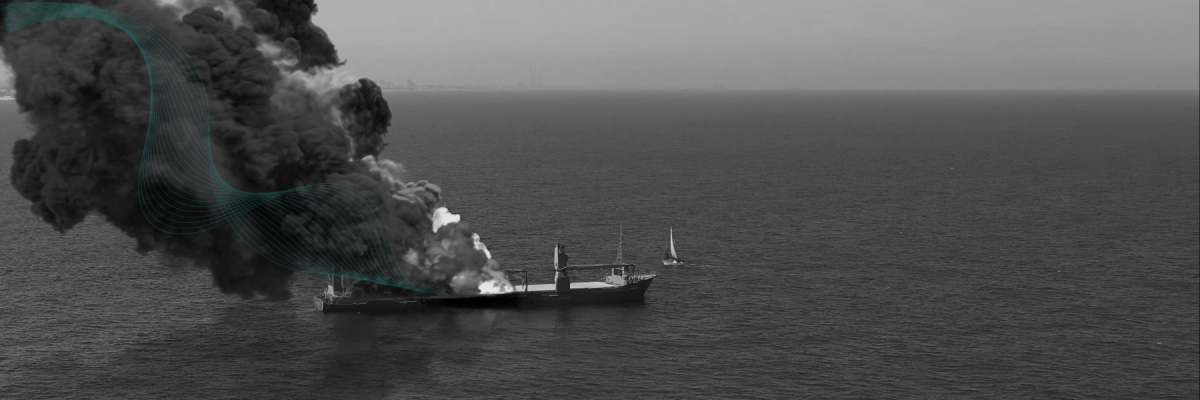Cargo Fire and Loss Innovation Initiative: Pioneering new technologies to prevent fires onboard ships
05/06/2024Recently we marked one year since the launch of the Cargo Fire and Loss Innovation Initiative (CFLII), it’s time to reflect on our journey, celebrate our achievements, and look ahead to the exciting future of maritime safety and sustainability
The Urgent Need for Innovation
Ship fires pose a significant threat to the maritime industry, endangering lives, causing environmental disasters, and damaging the reputation of global sea trade. With mis declared cargo and the rise of high-risk materials like lithium-ion batteries, the complexity of managing these risks has increased. Recognizing the urgent need for a collaborative approach, Safetytech Accelerator launched CFLII to bring together industry leaders to tackle these challenges head-on.
Building a Coalition of Innovators
From the outset, CFLII has been about collaboration. We brought together some of the biggest names in the shipping industry as Anchor Partners, including COSCO, Evergreen, Lloyd’s Register, Maersk, Ocean Network Express (ONE), Offen Group, Seaspan Corporation, TT Club, and UK P&I. These partners have been instrumental in defining challenges, evaluating technologies, and overseeing pilot projects.
Breaking New Ground in Fire Detection
Tackling the challenge of early fire detection is a complex and dynamic puzzle. CFLII Anchor Partners pinpointed the issue of early fire detection as a top concern, and the first two challenges addressed this in the cargo hold and on deck respectively.
When considering early fire detection from the perspective of technology, the market is highly saturated with a broad range of technologies ranging in cost, maritime experience, performance, and technological readiness. The first task of the programme was to navigate the technology landscape and shortlist technologies and organizations capable of delivering a performant solution.
The market is flooded with various fire detection approaches, thanks to the contributions of numerous organisations, big and small. Yet, each approach comes with its own mix of pros and cons when it comes to onboard deployment. The optimal solution might even involve a blend of different technologies. This tech spectrum spans a range of costs, complexities, and levels of maturity. Picking the right combination becomes a complex task.
Balancing scalability, cost-effectiveness, and performance is a crucial challenge. It’s not just about ensuring a secure maritime future; it’s about making strides towards an industry that’s not only safe but also environmentally sustainable.
Technologies Ruled Out for Early Fire Detection in the Cargo Hold:
- Distributed wired smoke detection systems
- Optical beam smoke detectors
- Non-infrared (IR) video detection
- Linear heat detection cables that degrade on contact with heat or do not represent adequate performance
- Graphene-based smart materials

These technologies were either not suitable due to performance issues or did not represent adequate technological readiness for onboard deployment.
Technologies Tested included five core technologies and three disruptors
Core Technologies
- Fibre Optic Linear Heat Detection (LHD)
- Sensor-based LHD
- IoT Networks
- Infrared (IR) Cameras
- Traditional Gas Sensing


Disruptors
- Radio Single State Disruptions Analysis
- Distributed IR Lense Networks
- Nanotube Chemical Signature Analytics

Testing technology within the maritime industry is inherently challenging due to various constraints and requirements. The programme conducts a variety of tests to evaluate whether a technology can address the challenge. These range from feasibility studies and laboratory tests to full onboard pilots. There is a significant emphasis on taking a scientific approach to testing, with Anchor Partners contributing to the design of experiments to ensure their questions are answered.
The programme seeks to find solutions that are at a high state of readiness but also collaborates with several early-stage partners conducting groundbreaking industrial research to accelerate their solutions into the market for the first time.
Outcome
So far within its first year, the programme has delivered three live pilots, two laboratory experiments, and seven feasibility studies across the technologies accepted into the programme. The programme is set to accelerate dramatically moving into its second year now that it’s up and running.
Sharing Our Insights
CFLII is not just about testing technology; it’s also about education and knowledge sharing. We’ve created an information hub, hosted webinars, and engaged with industry publications to spread the word about our findings and advancements. By sharing our insights, we aim to drive industry-wide progress in safety standards.
Looking Ahead to Year Two
As we move into the second year of CFLII, we’re gearing up for even more innovation and collaboration. New partners are joining us, and we’re expanding the scope of our technology trials. Existing challenges around early fire detection will continue, while new challenges exploring other areas of the cargo fire and loss paradigm will be mobilised. Year two will also see a much closer interface with class and regulation, ensuring that the solutions tested meet technical standards alongside delivering high performance.
Specific Plans for Year Two Include:
- Expanding Technology Trials: We will increase the number of technologies being tested within the programme, focusing on both mature solutions and innovative early-stage technologies.
- Addressing New Challenges: Beyond early fire detection, we will tackle other critical issues in cargo fire and loss, identifying and trialing technology to reduce risks such as losing containers overboard.
- Strengthening Collaboration: Closer collaboration with classification societies and regulatory bodies will be a priority to ensure that our solutions not only meet but exceed industry standards.
- Scaling Up: We aim to scale up successful pilots from year one, transitioning from feasibility studies and lab tests to more extensive onboard trials.
To mark the start of the second year we held person workshop with the Anchor partners in Marseille. The workshop highlighted the importance of continuing to build on the impact done so far in this area and to progress with trialling new technologies.
Safetytech Accelerator remains committed to advancing innovation in safety-critical industries, making the world safer and more sustainable through the wider adoption of technology. The progress we’ve made in the first year of CFLII is just the beginning. We’re excited about what’s to come and look forward to another year of ground-breaking innovation and collaboration.
Stay tuned for more updates and join us in our mission to enhance maritime safety and sustainability. For more information, visit: Cargo Fire and Loss Innovation Initiative (CFLII) – Safetytech Accelerator
Share this post

